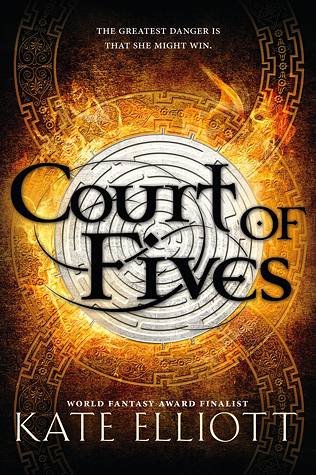Welcome to my stop on the Nobody's Goddess blog tour! Here author Amy McNulty goes into detail about some of the different masks the men wear in her book, and some of the magic behind it. If you haven't check out the book yet, be sure to do so after the guest post, and you can enter to win a digital copy at the end!
* * *
The
Men and Their Masks in Nobody’s Goddess: Common Masks the Men Wear
The first character in what would one day
become Nobody’s Goddess to cover his
face was the mysterious lord, and he wears a black veil wrapped around his
entire head (pinned at the shoulder and covered with a black minstrel-style hat
to make it look slightly less ridiculous). He’s the only character to make it
to the finished book from a shelved manuscript, and he was originally the only
one who covered his face.
When I decided to scrap most of that draft,
his character inspired my idea for the “hook” for the next one: What if all the
men in the village had to cover their faces? Why would that be? I settled on
the magic spell (some might say curse) that compels each man in the village to
devote himself to one woman, wherein he’s only able to remove his facial
coverings if he earns her love.
The magic works like this: a boy or man
who’s yet to have his love Returned (it’s a big deal—they capitalize the word
and everything) can show his face to any other male or to females who are
blood-related to him, so their mothers, sisters, aunts (by blood, not
marriage), grandmothers, and cousins can all look at them and not cause them
harm. The idea is that none of these women will prove their goddesses, the
women they’ll be in love with, and they all love these men and boys by default
as members of their family, so the men don’t have to prove themselves worthy of
these women’s love. I don’t think any man would risk showing his face to
distant relatives (like a second cousin once removed), as those could in fact
prove goddess material, but they feel safe around those in their immediate
family.
If any woman unrelated to a man looks upon
his uncovered face, he’ll die. The villagers don’t remember it actually
happening to anyone they know, but they’re not willing to take the chance and
try it to make sure the magic is working. It’s a peaceful village, and the
women in the village certainly don’t want to put men at risk. It’s easier for
men whose love has not yet been Returned to cover their faces so everyone can
be about their business.
Still, it’s hard to eat like that and it
does get rather stuffy for the poor boys even though they’re used to it, so the
villagers frequently allow boys to play and men to socialize in the Great Hall
without masks on and no women are allowed to enter during these times. Boys and
men who still wear masks will often eat together at home, too. Boys can take
off their masks around their mothers and sisters, so they can usually eat as a
family safely at home. No other woman would dare enter unannounced without
giving them a chance to cover up their faces.
I still wanted my veiled lord to stand
apart from the rest, so I decided that men in the village wore masks instead of
veils. (Although mothers tend to cover up their male babies by draping veils
over their bassinets.) They could really cover their faces with anything, but
they’ve lived this way for so many generations, they’ve made it a tradition to
wear animal masks for the most part.
Here
are three important types of masks the men in the village wear, which are all
made from wood and all have black veil material over the eyeholes so the boys
and men can see out through a hazy film, but women can’t clearly see in:
Everyday
Animal Masks
Men wear masks of their favorite animals,
which they know from the livestock fields and the woods in the village. (There
are no exotic animals they’ve never heard of.) So that means a lot of forest
and farm animals. (There are even some fish designs as there’s a large pond of
water in the livestock farm area.) Noll’s father, as the village’s primary
Woodcarver, carves most of the designs, but amateurs can make their own, or
they might buy them from Alvilda, Jurij’s aunt, a woman carver who took up an
occupation rather than pledge her love to the man who found the goddess in her.
They’ll also take hand-me-downs from previous generations.
Some boys prefer to wear mostly the same
mask and others have a lot of masks and they change them every day. Jurij and
his younger brother Luuk have a lot of masks because their aunt makes them and
there are hand-me-downs for Luuk. The carvers try not to repeat a design, or if
they do use the same animal, to make it unique enough that it’s easy for people
to tell the men and boys wearing them apart. Jurij’s and Luuk’s, for example,
have button noses because their parents are the village’s Tailors. Younger boys
wear a lot of cuter animal designs, like rabbits, kittens and puppies. Boys who
are more outgoing or older opt for more elegant or powerful designs like stags
and wolves.
Worn
Down Animal Masks
By the time they’re in their late teens,
most men can remove their masks because their love has been Returned. (They
even hold a special Returning ceremony when a goddess is seventeen or older and
is willing to proclaim her love for her man; during this, the man removes his
mask is front of everyone and enjoys a kiss from his goddess.) But there are
some women who simply don’t love the men who’ve found the goddess in them. Some
of these women are honest and tell their men to leave them alone as they’ll
never love them. In despair, these men move into what’s called “the commune,” a
collection of shoddy shacks at the edge of the village where unloved men are
depressed and do no good for the community because all they can think about is
how they love women who will never love them back. They still wear masks out of
habit or because they don’t want to die and be parted from their loves forever,
but they never change them, so they get worn down and cracked and chipped. To
make up for these men being of no use to the village, the women who reject them
take up an occupation themselves.
Some women will marry their men but still
not feel comfortable enough to perform a Returning. (If she’s not sure she
loves her man, she’ll kill him, and she can’t bring herself to risk that.) So
these men live somewhat normal lives with families, but they still can’t take
their masks off around any woman unrelated to them by blood—including their own
wives! They tend to wear the same mask, too, because they’re done with their
youthful days of fun, and the mask is more of a burden than a temporary thing.
Jurij’s father is still masked, and he always wears the same owl mask, which is
cracked and worn down.
Ceremonial Masks
There’s one special mask design that men
only wear twice in their lives (possibly more if they have sons), and it
resembles a man’s face. (Notice that they have pointed ears. All men in the
village do, but the women don’t.) It’s a symbolic gesture. He wears it for his
Returning ceremony, the last time he’ll ever have to wear a mask. The villagers
don’t know it, but the reason for this design originated many generations
before: If the man did die in the Returning, he at least had one opportunity to
walk around with a human face.
A man also wears this mask at his wedding,
which can’t occur until both he and his goddess are at least seventeen years
old. Many couples get married immediately after a Returning (during which the
woman must be at least seventeen, but the man can be younger), but sometimes,
if the man is younger or they want another celebration later, it’ll come weeks,
months or years after. The man wears this mask again as he walks up the aisle
to his bride-to-be and removes it when he stands beside her. His life is not in
danger anymore, but it represents who he used to be (a masked man) and how his
bride/goddess is the one who allowed him to remove his mask. A father escorts
his son down the aisle and also wears this mask to echo his son’s journey. (If,
like Jurij’s father, the father still has to wear a mask to protect his life,
he wears this human one on top of his animal one.)
It’s
easy to think of all the “what ifs…?” when it comes to the mask rules in the
village of Nobody’s Goddess. Believe
me, I spent a lot of time thinking about it! I’d love it if readers debated how
everything worked, and used all of the information revealed throughout the book
to understand how things got this way in the first place.
Amy McNulty is a freelance writer and editor from Wisconsin with an honors degree in English. She was first published in a national scholarly journal (The Concord Review) while in high school and currently spends her days alternatively writing on business and marketing topics and primarily crafting stories with dastardly villains and antiheroes set in fantastical medieval settings.
ABOUT THE BOOK
Title: Nobody's Goddess
Author: Amy NcMulty
Release Date: April 21, 2015
Publisher: Month9Books
Summary:
In a village of masked men, magic compels each man to love only one woman and to follow the commands of his “goddess” without question. A woman may reject the only man who will love her if she pleases, but she will be alone forever. And a man must stay masked until his goddess returns his love—and if she can’t or won’t, he remains masked forever.
Seventeen-year-old Noll isn't in the mood to celebrate. Her childhood friends have paired off and her closest companion, Jurij, found his goddess in Noll’s own sister. Desperate to find a way to break this ancient spell, Noll instead discovers why no man has ever chosen her.
Thus begins a dangerous game between the choice of woman versus the magic of man. And the stakes are no less than freedom and happiness, life and death—and neither is willing to lose.
Five (5) winners will receive a digital copy of Nobody's Goddess (INT)
a Rafflecopter giveaway
Check out the rest of the tour here!






























